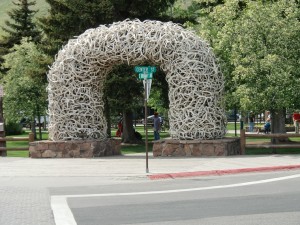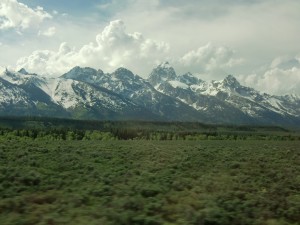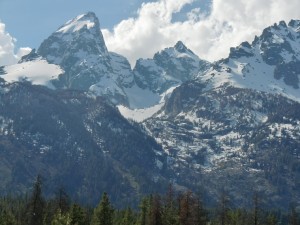THE BEST OF THE WEST – NORTH TO YELLOWSTONE (PART 2)
THE BEST OF THE WEST
This is the sixth in a series of articles about traveling the West by bus.
NORTH TO YELLOWSTONE (PART 2)
By Charles N. Stevens
Photos by Dolores Seidman
We arrive in Jackson, Wyoming, sometimes called Jackson Hole, in midafternoon, finally emerging from the cocoon of our bus to stroll the streets of the small town. Everywhere there are gift shops, art galleries and restaurants, but most interesting is the square park in the middle of town. At each corner is an arch composed entirely of intermeshed elk antlers, now weathered and bleached in the sun. I hear one little girl ask, “Did they have kill all those animals to get those horns?” “No,” her mother answers, “the animals shed their antlers and people find them.”
We walk into the refrigerated Million Dollar Cowboy Bar where barstools shaped like saddles are lined up along the long bar. A flash lights up the bar as a young man and woman have their picture taken posing on the unique saddle stools. We duck in and out. We tire of the unending shops selling huge pictures of bison, fur caps, blankets, expensive jewelry and a thousand other items.
Not wanting to be involved in the “cutsie” stuff, we sit in the park watching people and the flow of traffic around it. When the sun peeps out from behind a cloud it’s uncomfortably warm. A shiny black raven calls, his voice adding to the sound of cars. The town seems rather crass compared to the beauty of the mountains and valleys around it. Strolling on, we come to the Labyrinth of St. Johns Episcopal Church, a relatively quiet oasis at the edge of downtown. We spend our last moments there before boarding the bus to resume our journey.
On our way again, we soon look upon the majesty of the Grand Tetons, their sharp peaks draped with snow, one of the grandest sights in America. Towering clouds above them emphasize their height. Two antelopes graze in a field, the greenish color of the sage contrasting with the tan of their bodies.
We pause briefly at the Grand Teton National Park Visitors Center where we walk around in a forest of flagpole-straight lodgepole pines, the afternoon cloudy but warm, about 80 degrees. A thunderstorm quickly builds over the Tetons and soon the sky is deep gray, the mountains almost black—like an Ansel Adams black and white print.
Back in the bus, we cruise by Jackson Lake, the Grand Tetons mirrored in the still water, a sight that nearly takes our breath away. Two elk munch on the grass not far from the road.
Closer to Yellowstone, we spot a mother hunch-shouldered grizzly bear with her cub roaming in the meadow grass. Many other people had also noticed it and were lining up by the side of the road to film it. One foolish photographer had wandered farther out closer to the bear, a very dangerous act that rangers warn people about. As our bus rolled on, we wonder what might have happened to the man.
As we move on, I’m surprised to see patches of snow still lying among the trees. It’s the latter part of June! There is little evidence of the great fire that scorched Yellowstone in 1988, lodgepole pines now growing profusely in the formerly scorched land. That fire burned from June to November of that drought year, ceasing only when autumn snows began to fall. Lodgepole pine cones only open to release their seeds when the temperature is high, the heat of the great fire accomplishing this. Seedlings began to sprout the following year, producing the healthy 24 year-old trees that we see today.
We arrive in Grant’s Village within the park where we’ll stay for several days. The remains of snowdrifts, compact and dirty, still exist in the shady spots around our hotel. We’re assigned a very nice room, comfortable with good views of the forest and part of the sky out our windows.
After settling in our room, Dolores and I walk down a wooded slope to the shores of
Yellowstone Lake where a small café looks out over it. Swallows dart and gulls circle while ducks cruise in the mirror-like water. In the distance the slanting sun illuminates the last of a towering thunderhead. Two jackrabbits frolic in the forest behind us.
We enjoy our room and our chance to relax and rest until suddenly the power goes off.
We’re tired anyway, so it’s not really important. It is restored after 10 pm, but we’re ready to turn in.

An arch of elk antlers marks the entrance to the park in the center of Jackson, Wyoming.

Our first views of the Grand Tetons take our breathe away.

We get a closer look at these sharp peaks still laced with snow.

This is our final look at the Grand Tetons as the sky darkens into a thunderstorm.
MONTEREY PARK AUTHOR PUBLISHES 3RD BOOK ABOUT HIS EXPERIENCES IN WORLD WAR II- BACK FROM COMBAT
Charles “Norm” Stevens, a 40 year resident of Monterey Park and World War II Veteran has recently published the 3rd in his series about his experiences in WW II, Back from Combat: A WWII Bombardier Faces His Military Future. This book details the time from when he returned from combat in England where he flew 34 missions over Germany and France until the end of the war. Faced with large numbers of returning combat vets, and not knowing how long the war would continue, the military had to plan for their future. His options were whether to return to combat, become an instructor in the U.S., or receive new training that he would use in the Pacific. The book concludes with the end of the war with an Afterward that includes an update on the B-l7’s still flying in the U.S., as well as present day accounts pertaining to the war.
Stevens is the author of two previous books about his experiences:
An Innocent at Polebrook: A Memoir of an 8th Air Force Bombardier (Story of his 34 bombing missions from his base at Polebrook, England over Germany and France)
The Innocent Cadet: Becoming A World War II Bombardier (A prequel to the first, telling of his training in the U.S. before going overseas into combat.)
He is known to the readers of The Citizen’s Voice as the author of Travel Log Articles including “From Paris to Normandy on the Seine”, “Exploring New York” and “In Search of Snow.” He is retired, having taught for 32 years, primarily in the Montebello Unified School District.
Those interested in purchasing an autographed copy of any of his books, may contact the author at 323-721-8230 or Normstevens24@gmail.com.



